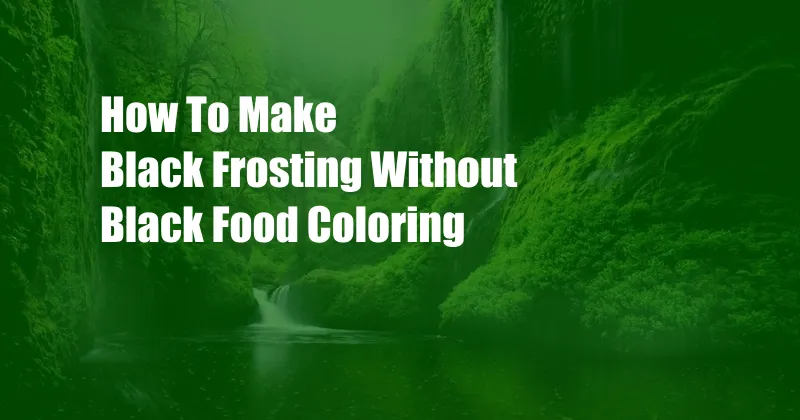
Unlocking the Secrets: A Comprehensive Guide to Creating Enchanting Black Frosting Without Black Food Coloring
An Enchanting Culinary Adventure
As a passionate baker, I’ve often found myself craving the enigmatic allure of black frosting, a shade that evokes both mystery and sophistication. However, the thought of using artificial food coloring always left a bittersweet aftertaste. Determined to embark on a culinary adventure, I sought to unravel the secret of crafting a tantalizingly black frosting without resorting to artificial hues. Here’s my journey and the secrets I unraveled along the way.
Natural Black Food Coloring: A Journey into Nature’s Palette
The quest for natural black food coloring led me down a fascinating path, where I discovered a plethora of botanical wonders. Activated charcoal, derived from coconut shells or bamboo, emerged as a safe and potent natural colorant. Its deep, inky hue promised to transform frosting into a captivating canvas. Another natural alternative I discovered was black cocoa powder, a cocoa powder processed with an alkalizing agent. While not as intensely black as activated charcoal, it imparts a rich, chocolatey flavor to the frosting.
Crafting the Perfect Black Frosting: A Step-by-Step Guide
With my natural colorants at hand, I set out to create the perfect black frosting.
-
Activated Charcoal Black Frosting: Combine 1 cup unsalted butter, 3 cups powdered sugar, 1/4 cup milk, 1 teaspoon vanilla extract, and 1-2 tablespoons activated charcoal powder in a large bowl. Beat until smooth and fluffy.
-
Black Cocoa Powder Frosting: Mix 1 cup unsalted butter, 3 cups powdered sugar, 1/4 cup milk, 1 teaspoon vanilla extract, and 1/4 cup black cocoa powder in a large bowl. Beat until velvety and dark.
Exploring the Latest Trends in Black Frosting
The realm of black frosting is constantly evolving, with new techniques and trends emerging. Ombre black frosting, which transitions from a lighter shade of black to a deeper hue, has gained immense popularity. Metallic black frosting, shimmering with an ethereal glow, adds a touch of glamour to desserts. Additionally, black frosting is being paired with colorful sprinkles, edible glitter, and other embellishments to create visually striking confections.
Tips and Expert Advice for Effortless Black Frosting Mastery
- Ensure your ingredients are at room temperature for optimal blending.
- Gradually incorporate the natural colorant to control the intensity of the black hue.
- Use a stand mixer or electric hand mixer for a smooth and fluffy frosting.
- Cover the frosting tightly with plastic wrap to prevent it from drying out.
- Store the frosting in the refrigerator for up to three days.
Frequently Asked Questions: Unraveling the Mysteries of Black Frosting
-
Q: Is it safe to use activated charcoal in frosting?
- A: Yes, activated charcoal is safe to consume in small amounts. However, it may interfere with certain medications, so consult a healthcare professional if you have concerns.
-
Q: Can I substitute regular cocoa powder for black cocoa powder?
- A: No, regular cocoa powder will not produce the same deep black color as black cocoa powder.
-
Q: How do I achieve an ombre effect with black frosting?
- A: To create an ombre effect, divide the frosting into two bowls. Add less natural colorant to one bowl and more to the other. Frost the cake with the lighter shade first, then gradually add the darker shade to the piping bag and pipe over the lighter shade.
Conclusion: Embracing the Magic of Black Frosting
The art of creating black frosting without black food coloring is a testament to the boundless creativity and culinary ingenuity that resides within us. By embracing natural ingredients and exploring innovative techniques, we can unlock the secrets of this enigmatic shade and transform our desserts into masterpieces of darkness and delight.
So, dear readers, are you ready to embark on your culinary adventure and conquer the enigmatic realm of black frosting? Your kitchen awaits, and the secrets are waiting to be unraveled.